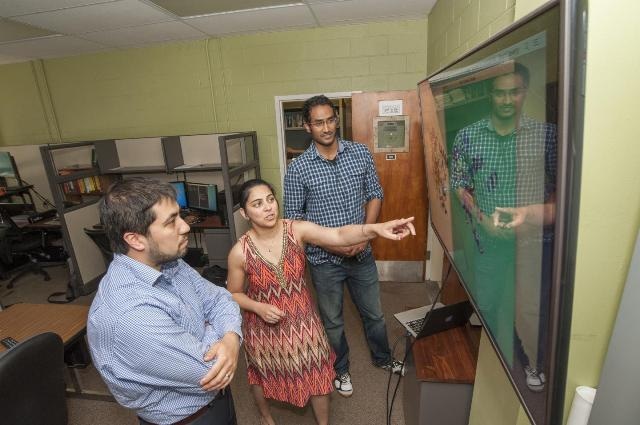Jun 29 2016
A study is under progress in the Clemson University to develop a new sensor. This sensor is being designed to aid in the detection of destructive weapons across the world, in order to protect the world from rogue nations and terrorists.
 Mark Blenner, left, listens as Sapna Sarupria points at a computer model in her Earle Hall lab at Clemson University. (Credit: Pat Wright/Clemson University)
Mark Blenner, left, listens as Sapna Sarupria points at a computer model in her Earle Hall lab at Clemson University. (Credit: Pat Wright/Clemson University)
Two assistant professors from the College of Engineering and Science, Mark Blenner and Sapna Sarupria, are in the process of creating a sensor that would detect signs of tributyl phosphate, a solvent that can enhance uranium, which is used in nuclear weapons.
Enzymes are generally used to find phosphate signatures. However, the means to increase the lifespan of enzymes to use them in sensors, has yet to be discovered by researchers. Blenner and Sarupria have been trying to achieve this for the past three years. Their project has been funded, with $487,000, by the Defense Threat Reduction Agency.
The technology is there to do this in the near term. What's missing is what our proposal addresses. It's understanding how to make these devices work reliably for long periods of time. The thing that goes bad most frequently is the biological component- the enzyme that's responsible for the detection.
Blenner
Both Blenner and Sarupria, faculty members in the Department of Chemical and Biomolecular Engineering, are approaching this enzyme challenge from two varied perspectives.
While Sarupria designs complex computer stimulations to evaluate the reaction of enzymes to different situations, Blenner conducts laboratory experiments.
It allows us to get a very detailed picture. Because of the simulations, we can look at a single atom at a time and begin to observe the behavior. It allows us a very high resolution, which then allows us to find those underlying principles.
Sarupria
Researchers hope to develop a compact, inconspicuous sensor that is capable of precisely and quickly detecting tributyl phosphate signatures. The sensor should also be able to detect signatures from appropriate distances that would provide enough time for the investigators to take crucial actions and decisions. The researchers intend to develop a sensor that can be deployed remotely, by being innocuously fastened to a uniform or disguised in the form of a leaf.
The main hurdle, for the researchers, is to find a way to immobilize the enzymes on a surface coated with polymer. It is on this polymer-coated surface that the chemical signals are converted into electric signals and are transferred to a computer.
We're really trying to understand the underlying molecular-level properties of the enzyme and the characteristics that lead to this behavior so that we can look at it more generally rather than having to find a solution each time we use a different enzyme.
Blenner, principal investigator.
"We want to find general principles that allow us to make smarter decisions about how to develop these systems to begin with."
This study can further enhance the basic understanding on enzymes that can be utilized in chemical industries, biotechnology and pharmaceuticals.
Douglas E. Hirt, chair of the Department of Chemical and Biomolecular Engineering, stated that the collaboration can pave way to novel discoveries.
"Bringing together experimental and simulation techniques lays the groundwork for innovative solutions," said Hirt, who is also working as associate dean for research and graduate studies in the College of Engineering and Science.
"Drs. Blenner and Sarupria are to be commended for this collaboration."
Recently, both Sarupria and Blenner have been the recipients of important awards.
Blenner was awarded by the Air Force Office of Scientific Research Young Investigator Program and was also awarded the NASA Early Career Faculty Award.
Sarupria was the recipient of an American Chemical Society OpenEye Outstanding Junior Faculty Award. She was also awarded the Doctoral New Investigator Award by ACS Petroleum Research Fund.